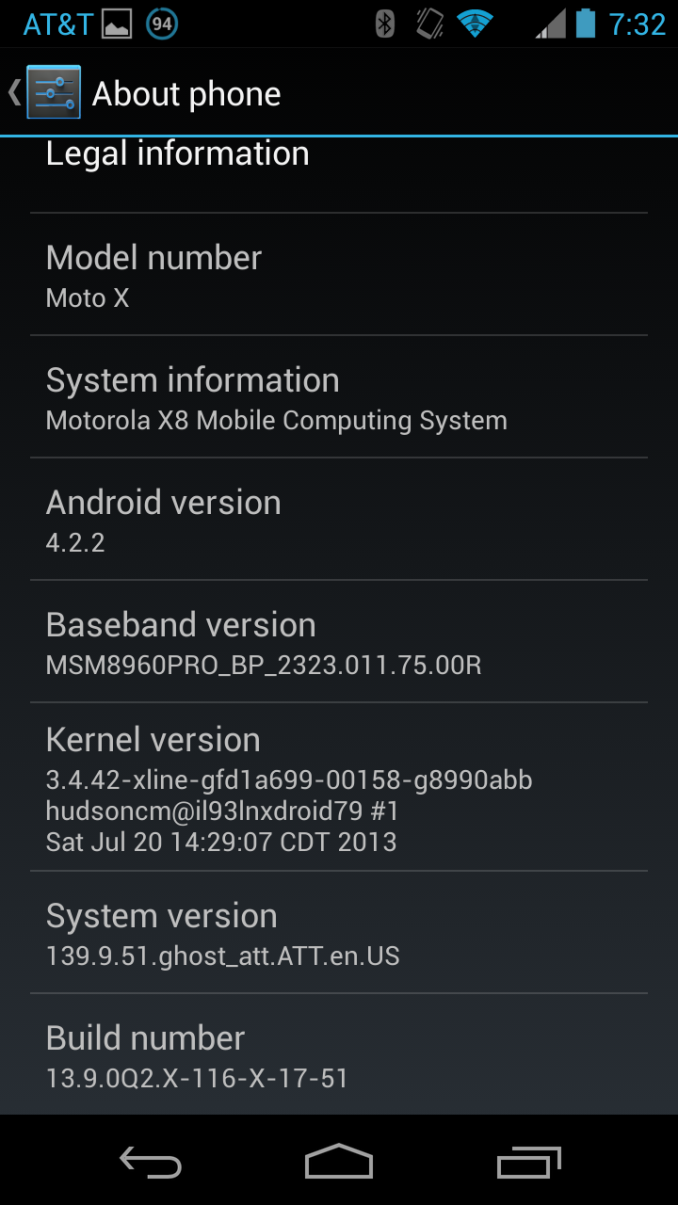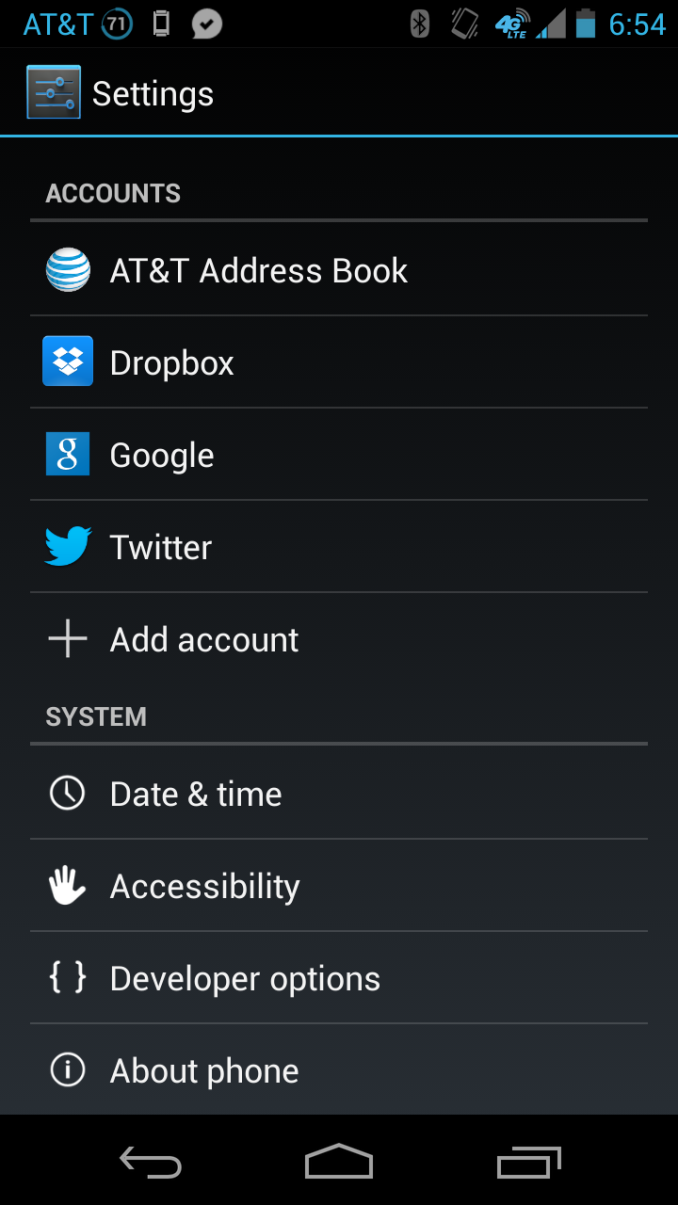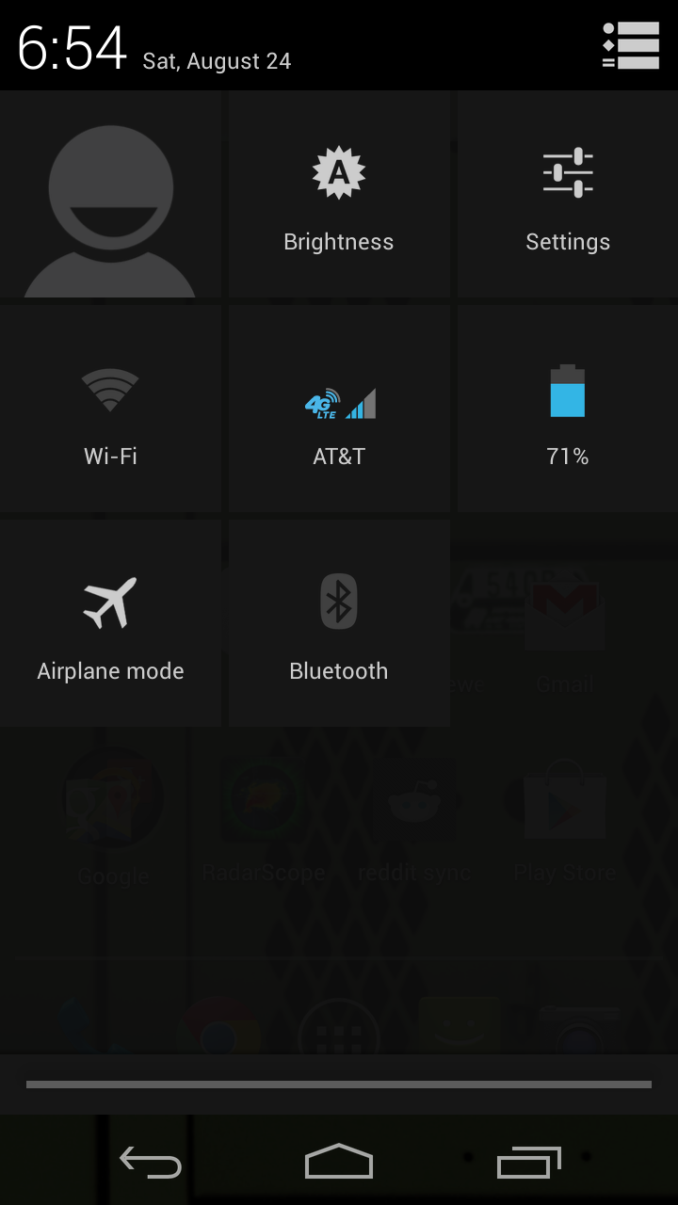Moto X Review
by Brian Klug on August 26, 2013 1:30 PM EST- Posted in
- Smartphones
- Qualcomm
- MSM8960
- Motorola
- Android
- Mobile
- Android 4.2
- Moto X
Somewhat Stock Android
One of the first things that changed for Motorola under its new Google ownership was the final nail through the coffin for Motoblur, with OTA updates for some of its handsets gradually scaling back customized features in favor of stock ones. I joked with Anand that Google paid $12.5 billion for Motorola just to kill the beast that was Motoblur. Truth be told the presence of largely-stock Android 4.x UI is perhaps one of the best qualities of the Moto X.
ro.build.version.full=Blur_Version.139.9.51.ghost_att.ATT.en.US
The Moto X at launch runs Android 4.2.2, which isn’t quite bleeding edge Android, but close. This is essentially an intentional side effect of the Google / Motorola firewalling that we’ve been told is in place. I’m not entirely surprised, but I had hoped the Moto X would differentiate itself by somehow launching with 4.3 considering other handset partners had the Jelly Bean MR2 (4.3) update a while ago, clearly Motorola should’ve as well. I know that Qualcomm had the BSP (Board Support Package) for 4.3 ready for MSM8960Pro at the same time as it did APQ8064, so I can’t think of any technical reason. Again I’d wager Moto X launching with 4.2.2 is entirely political, to say nothing of the usual operator testing nonsense in the USA.
Anyhow the homescreens (widget panels), launcher, settings menu, notification shade, dialer, and default applications are basically unadulterated Android. I say largely unadulterated because to say that the Moto X is entirely stock is still not quite true – there’s the operator name in the top left of the notification bar all the time, and the branded network status indicator (the cartoonish looking AT&T “4G” and “4G LTE” logos) on my AT&T unit. Unnervingly, the network status logo and bars are also a different shade of blue than the battery and time icons adjacent to it.
There’s also AT&T address book preloaded which cannot be removed, which is a huge annoyance. There’s also a provisioning check for bluetooth and WiFi tethering, another indication of an operator-touched device. There’s also AT&T my Wireless and AT&T’s visual voicemail app loaded, but those are pretty understandable.
The Moto X also has a few UI changes that definitely aren't stock. The status bar has different spacing for the cellular and WiFi indicator logos which carries over as a result of Blur (the spacing issue is just the "4G LTE" or similar status logo disappearing when on WiFi). Also the on-screen android buttons sometimes appear transparent, showing what's under, which definitely isn't a stock implementation.
My definition of stock is just that, totally stock – no branded logos, operator names everywhere, or any preloaded apps. Truth be told the Moto X isn’t stock, it just has the stock UI on top of a relatively standard Motorola software build, but it does have a heck of a lot less of the operator preload crapware that normally shows up on Android phones sold with a subsidy these days. Android’s visual style is now mature and appealing enough that it really doesn’t need customization or modification to look good, rather it just needs to be left alone as much as is politically possible. If there’s one thing the Moto X does that every other handset maker should take to heart, it’s exactly that.
If you’re on a wireless operator that can’t work with the newest Nexus phone or Google Play edition devices (like the CDMA ones in the USA – Verizon, Sprint, US Cellular), the Moto X might be the closest you can get to stock, even if it technically isn’t completely so. I suspect this will attract a lot of enthusiasts who are on other operators for their own reasons, even if the longer term solution really should be to vote with your wallet and move to an operator that’s open and compatible with those devices.














105 Comments
View All Comments
PC Perv - Monday, August 26, 2013 - link
Same for the screen. It's not as if everyone is in publishing industry. Human eyes are not limited to sRGB. Colors can be accurate or inaccurate, but there is no right or wrong ones. The author talks as if having larger gamut than sRGB in and of itself is always a negative. Ever looked into the ocean and be marveled at the nature's wonder?Friendly0Fire - Monday, August 26, 2013 - link
It is a negative if the software is not aware that the gamut is larger (hint: it isn't), causing incorrect colors.I doubt anyone at AnandTech would spit on an AdobeRGB screen if the OS and all software handled it properly, but that's just not happened and probably won't for the foreseeable future. In the meantime, accurate colors are better than higher gamut.
MartinT - Tuesday, August 27, 2013 - link
I'd argue that a large portion of what remains as a debate on optimal screen size is down to one particular supplier with considerable market share in the US not providing a model anywhere even close to what Brian (and the market) have zeroed in on as optimal.This is where Samsung's policy of trying absolutely everything comes real handy to anyone interested in cellphone trends.
quickbunnie - Monday, August 26, 2013 - link
Brian Klug didn't think he'd like the Moto X. After using it, Brian Klug liked the Moto X.Translation: This phone is frickin awesome!
Brian Klug - Monday, August 26, 2013 - link
I like it a whole lot more than I thought I would, still using it! :)-Brian
Fiebre - Monday, August 26, 2013 - link
I wish you guys could do a battery test on the Droid maxx. I would really appreciate it.icrf - Tuesday, August 27, 2013 - link
I second this point. I'm thus far assuming that, industrial design aside, all Moto X points apply to Droid Maxx, except battery life. The Verge posted their review and said the new Droid Maxx falls short of last year's Droid Razr Maxx despite having an inflated battery life number in the marketing. That said, everyone else's battery tests seem to do silly things like not calibrating the display to a standard, which means the tests are neigh useless. We need Anandtech's superior consistency.Honest Accounting - Sunday, September 15, 2013 - link
The battery test here isn't as "objective" as the reviewer claims. It uses a fixed "200 nits" screen brightness, which will favour current LCD technology (and Apple in particular) over OLED . To be credible the screen brightness on the battery test should be a percentage of maximum screen brightness.geniekid - Wednesday, August 28, 2013 - link
But would you prefer using the Moto X or the HTC One?Solandri - Monday, August 26, 2013 - link
I was a bit confused by the flash read/write performance charts. The standard in reviews seems to be to order them sequential r/w, then random r/w. I did a double take, then realized you'd ordered them write random/sequential, then read random/sequential. Different, but no big deal.Then I did a triple take and realized you'd ordered them write random/sequential, then read sequential/random. Coincidentally, this ordering is best-to-worst for the Moto X.
I trust your site's reviews enough to believe this was purely a coincidence, and that you switched the ordering because you led off by talking about the F2FS filesystem's write speed improvement (with the read speeds maintaining the traditional sequential/random order). But if you're going to switch around the order for the write speeds, you should switch the order of the read speeds to be consistent. The current ordering is not logical, and it gives the appearance of bias in favor of the Moto X.